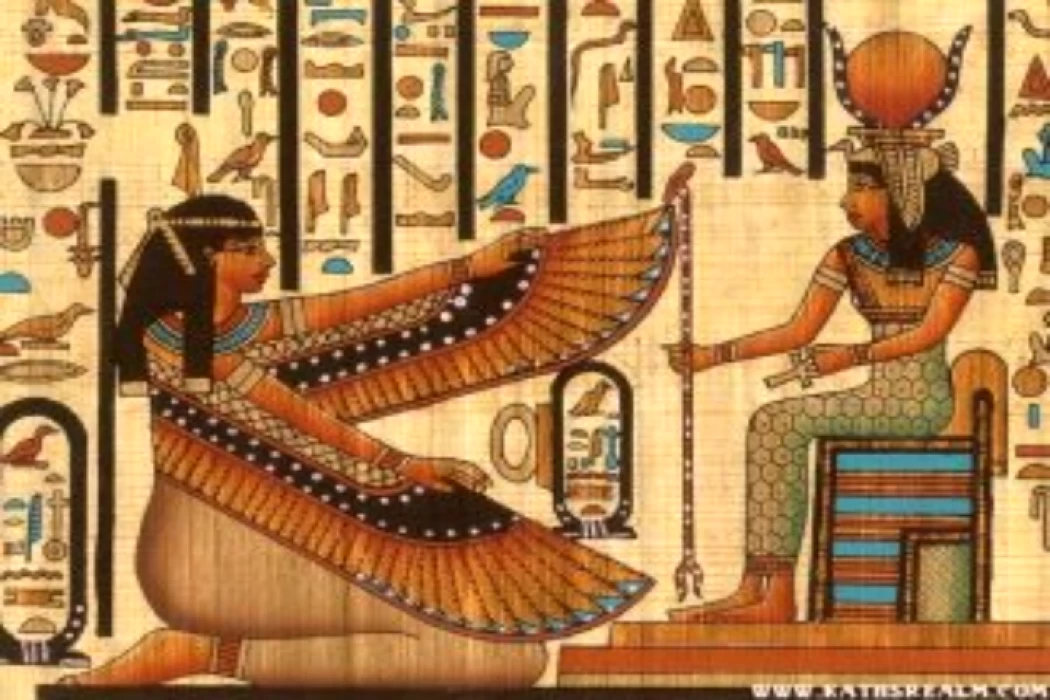
Deesse Nekhbet | Déesse égyptienne
Nekhbet était souvent représentée en train de déployer ses ailes au-dessus du souverain tout en saisissant dans sa griffe l'image du cartouche ou différents emblèmes. Le centre du culte de Nekhbet était El-Kāb, mais son épithète principale faisait d'elle l'immortelle de Hierakonpolis (ou Nekhen), la ville traditionnelle située en face d'El-Kāb, dans la région géographique du Nil.
Nekhbet était la patronne de la division administrative, montrant l'unité des "Deux dames" au sein du nom Nebty du souverain (avec son homologue Wadjet). Elle était typiquement connue sous le nom de "Hedjet" (couronne blanche) en rapport avec la couronne de la division administrative et apparaît fréquemment comme un dispositif héraldique représentant la division administrative. Elle était également la protectrice des enfants royaux et, plus tard, de tous les jeunes enfants et des femmes enceintes.
Il est prouvé que Nekhbet était déjà standard dans l'Égypte prédynastique, mais qu'elle était spécifiquement liée à la ville de Nekheb (son nom signifie véritablement "celle de Nekheb"). Cependant, à l'époque de la première famille, Nekheb et Nekhen (centre de culte de la divinité égyptienne l'Ancien) s'étaient incorporés et elle ou il et Wadjet étaient combinés pour former le nom Nebty du pharaon ; sa position en tant que représentante de la division administrative était absolument établie.
Les références dans les Textes des Pyramides (de la Cinquième Dynastie) assurent que Nekhbet était considérée comme une créatrice immortelle avec l'épithète "Père des Pères, Mère des Mères, qui a existé depuis le début, et qui est Créatrice de ce Monde". Elle était schématisée sur le vêtement Nemes du roi comme un vautour ou un serpent et sur le vêtement Vautour du quatrième peuple comme une excellente épouse royale.
Découvrez plus sur les dieux et les déesses de l'Égypte ancienne à travers des excursions de jour Luxor aussi si vous pouvez monter à bord du train pour un couple d'heures au nord, vous pouvez également le couvrir pendant des excursions de jour Aswan ou même nos 2 jours tour à Luxor d'Aswan il ya beaucoup d'Egypte excursions de jour qui vont à Luxor des différentes villes égyptiennes comme Hurgada excursions de jour par la terre à Luxor ou si vous venez pour des vacances de loisirs à Sharm vous pouvez prendre l'avion pour une journée au cours de Sharm El Sheikh excursions pour explorer toute la ville historique.
References within the Pyramid Texts (from the Fifth Dynasty) ensure that Nekhbet was thought-about to be a creator immortal with the epithet “Father of Fathers, Mother of Mothers, who has existed from the start, and is Creator of this World”. She was diagrammatical on the king’s Nemes clothing as a vulture or a snake and from the Fourth folk vulture clothing for an excellent royal spouse.
In ancient mythology, Nakhbet is considered a local goddess from the early pre-dynastic era. The goddess was called the patroness of the city of Nakhbet (Kaab), and she later became the patroness of Upper Egypt and was the second patroness of all of ancient Egypt when it was unified. In Egyptian religion, Nakhbet was seen by the people as the protector of all the rulers of Upper Egypt. Like a bird eagle the powerful goddess.
In ancient mythology, Nakhbet is considered a local goddess from the early pre-dynastic era. The goddess was called the patroness of the city of Nakhbet (Kaab), and she later became the patroness of Upper Egypt and was the second patroness of all of ancient Egypt when it was unified. In Egyptian religion, Nakhbet was seen by the people as the protector of all the rulers of Upper Egypt. Like a bird eagle the powerful goddess.
Nekhbet was often pictured as spreading her wings over the ruler while grasping in her claw the cartouch image or different emblems. She appeared as a girl, typically with a vulture’s head, sporting a white crown, and was generally delineated suckling the ruler. the middle of Nekhbet’s cult was El-Kāb, however, her principal epithet created her the immortal of Hierakonpolis (or Nekhen), the traditional city opposite El-Kāb, on the geographical region of the Nile River.
Nekhbet has been depicted since the beginning of the historical era in the form of a female vulture, which is still occasionally seen in Upper Egypt. She is usually depicted in profile or with wings spread in a straight pose, with only the head and feet depicted in profile. She is usually depicted holding the Sn sign in her talons, which signifies eternity or dominance. Nekhbet is identified with the goddess Wadjet, her counterpart in Lower Egypt, and thus Nekhbet is sometimes depicted as her serpent counterpart.
With Wadjet, she embodied one of the five royal titles, Nebty, meaning "the two ladies" or "belonging to the two ladies." Nekhbet also personified the crown of Upper Egypt. In human form, she may sometimes be depicted as a woman wearing a vulture-shaped headdress or crown, or she may wear the White Crown of Upper Egypt.
Nekhbet was the patron of administrative division, showing the unity of the “Two ladies” within the Nebty name of the ruler (with her counterpart Wadjet). She was typically known as “Hedjet” (White Crown) in relevance to the crown of the administrative division and frequently seems as a heraldic device representing the administrative division. She was conjointly a defender of royal kids and, in later periods, of all young kids and expectant mothers.
There is proof that Nekhbet was already standard in Predynastic Egypt however was specifically related to the city of Nekheb (her name truly means “she of Nekheb”). However, by the first family amount, Nekheb and Nekhen (cult center of Egyptian deity the Elder) had incorporated and she or he and Wadjet were combined to make the Nebty name of the pharaoh; her position as a representative of administrative division was absolutely established.
There was a huge cult cabin for Nakhbet at El Kab, although little remains of it. Since at least the Old Kingdom, Nakhbet has been characterized by the white crown of Upper Egypt, and was thus closely associated with the monarchy and the person of the king, so she was mythologically known as the "mother of the king." The pyramid texts depicted her as a mother goddess in the form of a large white cow. The pyramid texts depicted her as a matriarch in the form of a large white cow. In royal birth scenes, such as those found in the funerary temple of King Sahuros at Abu Sir, Nakhbet is represented as a nurturer or protective caretaker of the king.
There is proof that Nekhbet was already standard in Predynastic Egypt however was specifically related to the city of Nekheb (her name truly means “she of Nekheb”). However, by the first family amount, Nekheb and Nekhen (cult center of Egyptian deity the Elder) had incorporated and she or he and Wadjet were combined to make the Nebty name of the pharaoh; her position as a representative of administrative division was absolutely established.
Along with Wadjet, she embodied one of the five royal titles, Nebty, meaning "the two ladies" or "belonging to the two ladies." Nekhbet also personified the crown of Upper Egypt. In human form, she was sometimes depicted as a woman wearing a vulture-shaped headdress or crown, or she might wear the White Crown of Upper Egypt.
















